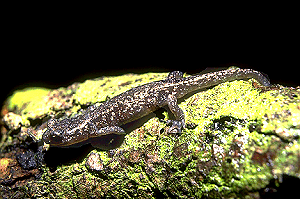
by Marc S Staniszewski

Description
The small genus Aneides comprises of just
5 species yet represents some of the most interesting salamanders in the world. The
majority of species occur along the western seaboard of the USA (Washington, Oregon and
California) and Vancouver Island, the Sierra Nevada Mountains, northern Mexico and a
relict population of an extremely rare species in New Mexico. One species occurs in
Eastern USA predominantly in Pennsylvania, Virginia, Kentucky and Tennessee with relict or
isolated populations in surrounding states. All are similarly sized within the 4 - 7 inch
(102 - 178mm) range and also have patterning which usually gives them excellent camouflage
against the habitats they usually inhabit. They are normally nocturnal although in certain
parts of the range (usually in primary undisturbed forest) I have observed these
salamanders during daylight in cooler parts of the year. Their stealth and pursuit of prey
is unsurpassed in the caudata world. They are equipped with an extensible tongue which
they use to snare small invertebrates. Their vision is also excellent. Another unusual
trait is the fact that these salamanders sometimes appear to be grazing on algae and/or
lichens on tree bark with the outward projecting teeth (gently move a finger along the
snout of these salamanders to feel these small projections). Whether they are actually
feeding on the plant material or on microbes that live on the vegetation is not currently
understood. The generic names comes from their climbing abilities although some species
spend much of their life on the ground. They are all equipped with well-developed rounded
or square toe-pads which allow excellent grip on tree bark, plant stems, rocks and even
glass.
Unfortunately Aneides are not regularly available in captivity due to their rather
small or fragmented ranges and some species are becoming increasingly rare due to habitat
loss, especially in central California.
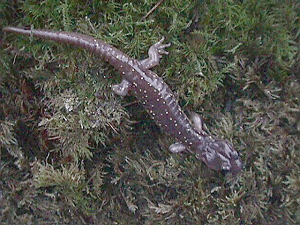
The arboreal salamander (Aneides lugubris)
is
the stockiest species of the genus Aneides
The Species
(* Not recognised by Stebbins in the latest revision of Peterson's 'Field Guide to Western Reptiles and Amphibians'.)

The coastal redwood habitat of
the clouded salamander (Aneides ferreus)
Species Descriptions
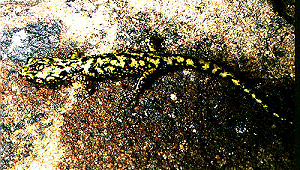 The green salamander (Aneides aeneus). Adult above. Juvenile (captive bred in 2000) to the right. |
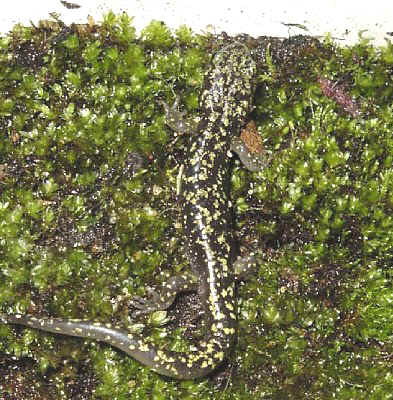 |
Green Salamander - (Aneides aeneus)
This truly beautiful stream-lined species attains a maximum of 5½ inches (140mm) with
4 inches (102mm) being more usual. A wonderfully patterned species with a network of green
and black markings which renders it almost invisible against lichen- encrusted rocks.
Juveniles are identical in coloration to adults although they appear more plump. The toes
are more squared than in other Aneides. Occurs in southern Ohio, southwest
Pennsylvania, extreme west Maryland, West Virginia, western Virginia, eastern Kentucky,
central eastern Tennessee, extreme northeast Mississippi, northern Alabama, extreme
northwest Georgia, northwest South Carolina and southwest North Carolina. Within its range
populations are rather scattered and disjunct due to fairly specific habitat
preferences. Sandstone rock faces with numerous damp (but not wet) crevices, nooks and
crannies are the preferred habitat although beneath the bark of rotten trees, talus rocks
piles and log piles are also favoured. However, even in seemingly suitable habitats it may
be absent and therefore other factors may play a part in distribution.
With the aid of a torch and long cocktail stick, Erik Keyster and myself were able to
capture a number of these salamanders in a sandstone rock area at 3,000m elevation in
southern Tennessee in 1995. These ranged in sized from a 30mm juvenile to a large 130mm
male. Please note these were subsequently released.
Clouded
Salamander - (Aneides ferreus)
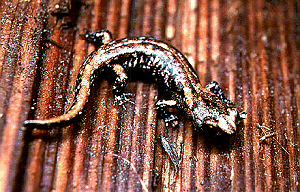
A juvenile clouded salamander (Aneides ferreus)
observed in Humboldt State Park, Northern California
Recently divided into two species after DNA analysis, this species attains 4 inches (101mm). It is locally abundant where it occurs but again is often absent from seemingly suitable habitat within its range. The dorsum is dark brown or black with a silvery grey or green lichen-like pattern. Juveniles possess a coppery or red tail stripe and are slimmer. Quite variable, in some populations the silvery markings are reduced or reddish markings may be present. Eyes possess a golden upper iris. Occurs in extreme northern California to the western slope of the Cascade Mountains in Oregon. On recent trips to southern Oregon I discovered this species in fairly large numbers especially in the natural and man-made clearings (trails, car-parks, camping grounds) of redwood groves. Beneath the loosened bark of toppled trees, or even leaf and detritus piles built up on the flat surface of lopped trees seemed to be favoured retreats. Juveniles outnumbered adults by 2 : 1 in sampled areas. Moisture seems important to the activity of these salamanders because on previous trips during drier times very few specimens were observed.
Wandering
Salamander - (Aneides vagrans)
The natural range of this species is in the humid coastal forests of northern Siskiyou and Del Norte Counties to northern Sonoma County, California where it overlaps but apparently rarely intergrades with A. ferreus in the extreme northern part of this range. It also extensively occurs on Vancouver Island, surrounding islands and increasingly on British Columbia, western Canada where it was thought to have been introduced from California. It may have hitched a ride on logs used by the tannery industry - a theory that is the result of modern DNA analysis. Externally very similar to but smaller than A. ferreus, from which it is derived attaining a maximum size of 3¼ inches (82mm).
Black Salamander - (Aneides flavipunctatus)
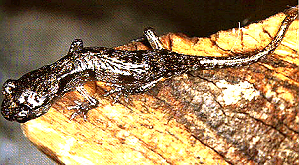
Santa Cruz Black Salamander (Aneides flavipunctatus niger)
is probably one of the rarest salamanders in the world.
This specimen was one of eight captive bred by myself in 1993
from specimens given to me by a friend in Boulder Creek, Santa Cruz Co.
A small, relatively plump species measuring 3 -
4 inches (76 - 102mm). The dorsum ranges from inky black without markings in Aneides
f.flavipunctatus to black with lots of silvery,yellow or rarely gold speckles in Aneides flavipunctatus niger. Juveniles of the latter
subspecies have similar patterning interrupted by black bars. Juveniles are more
streamlined than adults with a proportionally larger head. This species ranges from the
Santa Cruz Mountains in central-west California to southwest Oregon. Nowhere have I found
it to be as common as Aneides ferreus or A.lugubris. Compared to other species Aneides
flavipunctatus (along with Aneides ferreus)
is less arboreal and is often found beneath logs and rocks on the forest floor. When I
discovered this species in the San Franciscan Bay area, it was always found beneath logs
nestled on streams that had run dry but still retained some degree of moisture. During
December in Big Basin Redwoods State Park I discovered several Santa Cruz black
salamanders sitting stationary on top of logs in full (but weak) sun. Even when
disturbed they made no attempt to escape.
Sacramento Mountains Salamander - (Aneides
hardii)
At a maximum of just 3 - 3½ inches (76 - 89mm) this federally protected species is the
smallest of the Aneides. Its slim body ranges from dark brown to bronze with dark-green or
grey patches. Toe tips are rounded and the belly is lightish grey or sometimes cream.
Juveniles are of an identical pattern although they possess a distinct brown-bronze dorsal
stripe. Although this species is probably not as rare as the more localised Santa Cruz black salamander (Aneides flavipunctatus
niger) proper research into the latter has never been exhaustively carried out. It
occurs in the vicinity of the Sacramento, White and Capitan Mountains of southern New
Mexico occurring at altitudes ranging from 8,300 to 11,700 feet where it is generally more
common on northern and western slopes. Due to its southerly distribution, its period of
observable activity coincides with the rains from June to August. In the important paper
'The Natural History of the Salamander Aneides hardii' by Johnson and Schad (1959),
they explained how this species is often found beneath the bark of rotten timber
(especially Douglas Fir) and talus rock piles. Clutches of eggs are deposited deep within
sodden rotten wood that is 'punky' and almost ready to collapse.
Arboreal Salamander - (Aneides
lugubris)
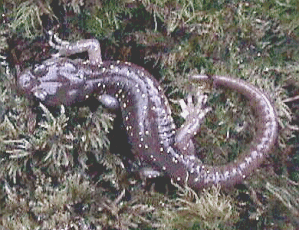
The arboreal salamander (Aneides lugubris lugubris)
The most familiar species of the genus, Aneides
lugubris attains 2½ - 4½ inches (64 - 114mm) and is easily distinguished by its
incredibly well-formed jaw-bone muscles, especially in males. The smooth, plump body is
brown to chocolate and often displays very small yellow spots. In the Farallon subspecies Aneides lugubris farallonensis, these spots are much more
conspicuous. The belly is cream or white, the toes possess square tips and the tail is
highly prehensile. Juveniles are darker, sometimes black with heavy yellow or gold
speckling and the base of the limbs possess a yellow or gold blotch. They are easily
confused with juveniles of Aneides flavipunctatus
niger in the Santa Cruz region. Although it is reported to be the 'champion
climber' being found 60 feet up in woodpecker holes and bark piles collected in between
branches, I have always found this species beneath large sections of rotting logs which
are usually within a clearing. In Big Basin Redwoods State Park near Boulder, Santa Cruz,
literature in the small nature museum explains how this species frequents the wooden
buildings of the park often crawling unsuspectingly onto someone's shoulder. Distributed
from Humboldt County to northwest Baja California, Mexico and also on many islands of the
central and southern California coast including South Farallon, Catalina and Los
Coronados. Also occurs on the western slopes of the Sierra Nevadas.
Captive Care
Housing
Aneides demand vivarium designs that replicate, at least in part, their natural
habitat. The base of the vivarium should comprise of a moist (not sodden) layer (2 - 4
inches depth) of material such as a forest chipped bark, sand and peat mixture. Several
small ferns can be planted as can be various clump mosses which should be misted regularly
to encourage growth. Next is to build up the decor. For Aneides aeneus this entails
creating miniature sandstone, granite or talus rock piles with plenty of moist cavities
which may provide suitable nesting sites. It is important to ensure that rocks where used
are kept uniformly moist. This can be achieved by packing the gap behind the rocks with
moist river sand and watering this regularly. Capillary action will ensue with rocks
drawing enough moisture to maintain a damp surface. The green salamanders may even tunnel
into the sand and nest. All other species require sections of dampened tree stumps or
thick branches where the bark is loosened to provide refuge during the day. Large pieces
of cork bark or tree bark can also be spread over the substrate. The whole vivarium should
be misted daily but it is important to not make it sodden. There is actually no need for a
water source although a small trickling waterfall will not only look appealing but also
maintain humidity at an acceptable level. As all Aneides are excellent climbers (and will
easily scale glass), it is important to ensure the vivarium is escape proof. In addition
it must have good ventilation to prevent a stuffy atmosphere.
Lighting
There is certainly no requirement for UVB lighting (unless live
plants are maintained in the terrarium) because arboreal salamanders are primarily
nocturnal or crepuscular. Locating the terrarium in a well lit place (but not in direct
sunlight) will provide them with the photoperiods necessary to promote breeding.
Temperature/Humidity
In the wild, during warm weather Aneides will crawl deep into damp cool crevices, rotting
logs or beneath tree roots. However, even during July my colleague Erik Keyster discovered
that Aneides aeneus were active on warm nights (temperature 72 - 76°F.) even
though daytime highs were in the high 80's/low 90's. West coast Aneides would
appear to be just as tolerant of these warm temperatures although peak activity is reached
during spring and early summer when daytimes are cool to warm and nighttimes are cool.
Significantly, during this period, rainfall is prevalent and therefore humidity is quite
high. During much cooler, damper weather Aneides may even forage during the day as
I discovered in Big Basin Redwoods State Park. One species - Aneides hardii - is
very susceptible to high temperatures and probably would not tolerate anything above
74°F.. Its high altitude, hostile habitat means that during most of the year is leads a
subterranean existence or hibernates. However, this species is not generally available in
captivity.
Generally speaking then, maximum temperatures should be between 50 and 68°F. Unless such
temperatures can be constantly maintained then there really is no point attempting to keep
Aneides as they will simply die. Heat stress is a well documented fatality in
plethodontid salamanders. Temperature governs reproductive, feeding and hibernation
behaviour. In the wild these salamanders are able to move deep underground to escape heat.
In captivity they do not have such opportunities. In some areas it may be necessary to
install some sort of air cooling/conditioning device, or I have personally utilized an old
refrigerator, converted into a glass fronted cool terrarium for maintaining many
plethodontid salamanders. Humidity is also important. Being plethodontid or lungless
salamanders, the exchange of oxygen and waste gases through the skin demands a moist
environment. Mist the terrarium three or four times daily, using a slightly acidic water
(clean rainwater which is free from pesticides/herbicides is ideal). DO NOT close off
ventilation points to increase humidity. This will result in stale air and
fungal/bacterial explosions which will prove far more harmful. Always ensure there is
excellent ventilation.
Feeding/Watering Regimes
Misting of the cage should take place just before lights are switched on/near dawn and
just before dusk/lights are switched off. Aneides are able to capture surprisingly large
insects with their extensible (chameleon like) tongue. Food consists mainly of insects,
including fruitflies, spiders, 3 - 7mm crickets, small waxworm, freshly sloughed
mini-mealworm and caterpillars. Crickets should be gut-loaded with carrots, oranges and
other nutrients. Food can be dusted every other sitting with a vitamin supplement such as
Rep-Cal. It is a joy to watch these salamander stalking their prey like a cat even during
full daylight. Aneides are not greedy feeders and may take only one or two food items per
day. They rarely become obese in captivity.
Dormancy
Dormancy appears to be important where breeding is concerned. All Aneides require a
brief hibernation period from December to February (Aneides hardii disappears from
September until May in its habitat) at temperatures of around 44°F.. I hibernate my
specimens in a refrigerator but ensure that the container is given air for 2 hours each
day. Only attempt to hibernate sexually mature and well-fed Aneides. Yearlings and
two yearlings should be cooled to a minimum of 50°F.. Aneides may also undergo an
aestivation period in the wild but in breeding Aneides flavipunctatus niger I found
this not to be necessary. If you do plan to aestivate Aneides place them in an
escape-proof plastic shoe box or old aquarium filled with damp (not too damp) newspaper.
Place the container somewhere where the temperature is around 70°F. certainly not above
75°F. for a maximum of 4 weeks. If they show signs of desiccation then remove
immediately.
Breeding
Correct hibernation, temperature and humidity regimes are
essential in reproduction. Courtship usually takes place in winter with eggs being laid in
spring. There is no aquatic stage, mating, egg deposition or larvae. Males are
distinguished by the presence of two cirri on the upper lip (small pointed projections),
are usually more stream-lined, have a wider head or possess a distinct mental gland. In Aneides
aeneus eggs are suspended by a pedicel to a cave or crevice roof which is moist or has
high humidity and a cool atmosphere. Other species deposit their eggs deep within rotting
logs, in moist tree holes or underground within hollows under tree roots. These may or not
be suspended by a pedicel. Females usually tend to eggs (especially in Aneides aeneus
and A.hardii) where she will secret moisture to ensure they do not desiccate. The
eggs are between 3 and 7mm and white to white-yellow in colour. Number of eggs ranges from
just 3 - 4 in A.hardii to 22 in A.aeneus. Larval development takes place
entirely within the egg shell. Miniature replicas of the parents hatch out after 50 - 90
days. Juvenile coloration is different to adults in West Coast species. They measure 30 -
40mm on hatching (depending on species) and must be separated from the adults who may
accidentally bite of a leg or even devour them whole. Rearing such small creature requires
patience and care. Maintain them in containers of moist sphagnum moss or newspaper (NEVER
allow this to dry out) and provide a diet of small aphids, sweepings, hatchling
mini-waxworm. Within 2 - 4 weeks they are able to take relatively large crickets and will
grow steadily to reach maturity in 12 - 24 months.
Other Comments
Longevity is in the 3 - 10 year range (apparently Aneides hardii has only survived
18 months in captivity due to specific requirements). Handling of arboreal salamanders
must be kept to a minimum. The skin is rather delicate and can be easily damaged. Always
wet hands before handling these and any other plethodontid salamanders.
Please note that all
Ensatina species/subspecies and other amphibians are strictly protected within U.S. State and National Parks and should not be collected unless you have special authorisation to do so.References
Information gathered from the following books/persons was used in the generation of this page.
1.) The Audubon Society Field Guide to
North American Reptiles & Amphibians - Bebler & King, Knopf Publishing
2.) Discovering Sierra Reptiles and Amphibians - Harold E.Basey, Yosemite Association
3.) Salamanders of the Family Plethodontidae - E.R.Dunn, SSAR Reprint
4.) Amphibians & Reptiles of the Pacific States - Gayle Pickwell, Dover Publications
5.) Reptiles and Amphibians of Eastern/Central North America - Conant & Collins,
Peterson Field Guides
6.) Western Reptiles and Amphibians -Robert C.Stebbins, Peterson Field Guides
7.) Amphibians and Reptiles of Kentucky - Barbour, Lexington University Press
8.) The Natural History of the Salamander Aneides hardii - Richard F Johnson and
Gerhard A Schad
9.) Erik Keyster - General Observation of Green Salamanders (Aneides aeneus) in his
collection
| 10.) Amphibians in
Captivity (TFH) - Marc Staniszewski (1995) |
 |
All text and photo's - Copyright ©1996-2002 Marc Staniszewski
Most recent revision: 06/08/2002